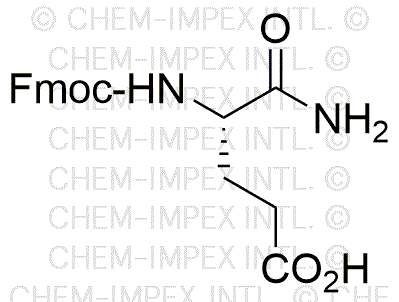Fmoc-Glu-NH2 is widely utilized in research focused on:
- Peptide Synthesis: This compound serves as a key building block in the synthesis of peptides, allowing researchers to create complex structures for various applications in drug development.
- Drug Discovery: Its role in modifying amino acids makes it essential in the design of novel therapeutics, particularly in targeting specific biological pathways.
- Bioconjugation: Fmoc-Glu-NH2 is used in bioconjugation processes, enabling the attachment of biomolecules to surfaces or other molecules, which is crucial in developing biosensors and diagnostic tools.
- Research in Neuroscience: This compound is valuable in studying neurotransmitter systems, as it can be incorporated into peptides that mimic or inhibit natural signaling pathways.
- Protein Engineering: It aids in the modification of proteins, enhancing their stability and functionality, which is vital for applications in biotechnology and pharmaceuticals.
General Information
Properties
Safety and Regulations
Applications
Fmoc-Glu-NH2 is widely utilized in research focused on:
- Peptide Synthesis: This compound serves as a key building block in the synthesis of peptides, allowing researchers to create complex structures for various applications in drug development.
- Drug Discovery: Its role in modifying amino acids makes it essential in the design of novel therapeutics, particularly in targeting specific biological pathways.
- Bioconjugation: Fmoc-Glu-NH2 is used in bioconjugation processes, enabling the attachment of biomolecules to surfaces or other molecules, which is crucial in developing biosensors and diagnostic tools.
- Research in Neuroscience: This compound is valuable in studying neurotransmitter systems, as it can be incorporated into peptides that mimic or inhibit natural signaling pathways.
- Protein Engineering: It aids in the modification of proteins, enhancing their stability and functionality, which is vital for applications in biotechnology and pharmaceuticals.
Documents
Safety Data Sheets (SDS)
The SDS provides comprehensive safety information on handling, storage, and disposal of the product.
Product Specification (PS)
The PS provides a comprehensive breakdown of the product’s properties, including chemical composition, physical state, purity, and storage requirements. It also details acceptable quality ranges and the product's intended applications.
Certificates of Analysis (COA)
Search for Certificates of Analysis (COA) by entering the products Lot Number. Lot and Batch Numbers can be found on a product’s label following the words ‘Lot’ or ‘Batch’.
*Catalog Number
*Lot Number
Certificates Of Origin (COO)
This COO confirms the country where the product was manufactured, and also details the materials and components used in it and whether it is derived from natural, synthetic, or other specific sources. This certificate may be required for customs, trade, and regulatory compliance.
*Catalog Number
*Lot Number
Safety Data Sheets (SDS)
The SDS provides comprehensive safety information on handling, storage, and disposal of the product.
DownloadProduct Specification (PS)
The PS provides a comprehensive breakdown of the product’s properties, including chemical composition, physical state, purity, and storage requirements. It also details acceptable quality ranges and the product's intended applications.
DownloadCertificates of Analysis (COA)
Search for Certificates of Analysis (COA) by entering the products Lot Number. Lot and Batch Numbers can be found on a product’s label following the words ‘Lot’ or ‘Batch’.
*Catalog Number
*Lot Number
Certificates Of Origin (COO)
This COO confirms the country where the product was manufactured, and also details the materials and components used in it and whether it is derived from natural, synthetic, or other specific sources. This certificate may be required for customs, trade, and regulatory compliance.


